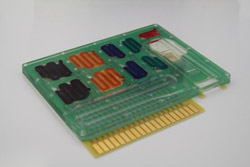Chagas – a neglected disease

Microfluidic cartridge with integrated reagents and pumps, developed as part of the Fraunhofer ivD platform <br>(http://www.ivd-plattform.fraunhofer.de).<br>Photo: Fraunhofer ENAS / Andreas Morschhauser<br>
Around the world, almost 10 million people are infected with the disease – mostly in Central and South America and parts of the USA. Tourism and immigration, however, are also bringing the disease to Europe.
One bite can have fatal consequences
The disease is passed on by blood-sucking bugs of the Reduviidae family, whose bite contaminates the wound and ultimately transmits the infection. The acute phase of the illness starts after four weeks and can last up to another four weeks. 30 – 40% of infected people have symptoms such as local redness, swelling around the wound, fever, and nausea. Treatment is only effective if started in this phase of the illness.
After a symptomless stage, which can last for years, the chronic, acute and frequently fatal phase of the illness begins. In 20% of cases, the heart and alimentary organs expand until they fail.
Scientists are concerned because there is still no inoculation. Current methods of treatment not only have serious side effects, they are also unaffordable for many patients.
Effective test offers a chance for a treatment
Under the direction of Fraunhofer ENAS, a European-Brazilian consortium is developing an on-site test, similar to a laboratory analysis, that can detect the infection quickly and reliably.
Scientists from eight European and five Brazilian research institutions and companies are developing a compact, low-cost detection system that can find the pathogen at any location. Three partners of the Heterogeneous Technology Alliance HTA are among them: CEA Leti from France, the Fraunhofer Institute for Electronic Nanosystems ENAS from Germany, and Teknologian tutkimuskeskus VTT from Finland.
The pathogen is detected in, say, a blood sample by searching for both its own DNA and the immune response from the patient’s body. The test allows highly specific diagnosis in all stages of the infection. Including sample pretreatment, the entire test system is the size of a cellular phone.
The researchers are receiving funding from the European Union and the National Council for Scientific and Technological Development in Brazil. The project “PodiTrodi – Technology platform for Point-of-care diagnostics for tropical diseases“ (EU-FP7-287770) started in September 2011 and was planned to run for two and a half years. The system will later be used as a technology platform for other tropical diseases.
Further information is available at http://www.poditrodi.org.
European consortium:
• Fraunhofer ENAS (Germany)
• CEA Leti (France)
• Teknologian tutkimuskeskus VTT (Finland)
• ST Microelectronics (Italy)
• Haecker Automation GmbH (Germany)
• University of Aveiro (Portugal)
• CNRS, University of Montpellier, Laboratoire Charles Coulomb (France)
• BiFlow Systems GmbH (Germany)
Brazilian consortium:
• Centro de Tecnologia da Informação Renato Archer (CTI)
• Fundação Centros de Referência em Tecnologias Inovadoras (CERTI)
• Fundação Oswaldo Cruz (FioCruz)
• Centro de Componentes Semicondutores, Universidade Estadual de Campinas-UNICAMP
• Universidade Federal do Paraná
Contact:
Christian Lüdemann
Phone +49 30 688 3759 -6103
christian.luedemann@mikroelektronik.fraunhofer.de
Fraunhofer Group for Microelectronics VµE
Anna-Louisa-Karsch-Strasse 2
10178 Berlin
Germany
Media Contact
All latest news from the category: Life Sciences and Chemistry
Articles and reports from the Life Sciences and chemistry area deal with applied and basic research into modern biology, chemistry and human medicine.
Valuable information can be found on a range of life sciences fields including bacteriology, biochemistry, bionics, bioinformatics, biophysics, biotechnology, genetics, geobotany, human biology, marine biology, microbiology, molecular biology, cellular biology, zoology, bioinorganic chemistry, microchemistry and environmental chemistry.
Newest articles

Making diamonds at ambient pressure
Scientists develop novel liquid metal alloy system to synthesize diamond under moderate conditions. Did you know that 99% of synthetic diamonds are currently produced using high-pressure and high-temperature (HPHT) methods?[2]…

Eruption of mega-magnetic star lights up nearby galaxy
Thanks to ESA satellites, an international team including UNIGE researchers has detected a giant eruption coming from a magnetar, an extremely magnetic neutron star. While ESA’s satellite INTEGRAL was observing…

Solving the riddle of the sphingolipids in coronary artery disease
Weill Cornell Medicine investigators have uncovered a way to unleash in blood vessels the protective effects of a type of fat-related molecule known as a sphingolipid, suggesting a promising new…





















